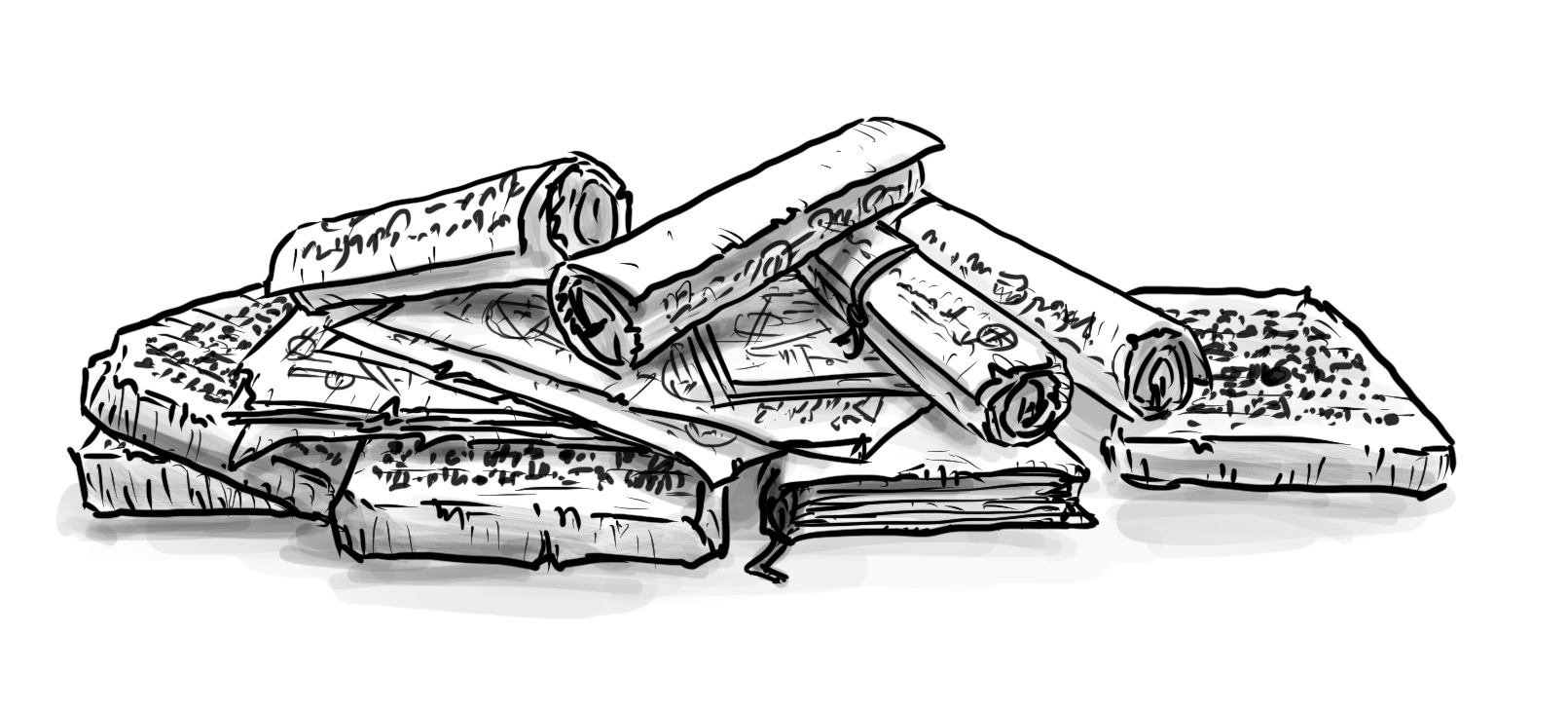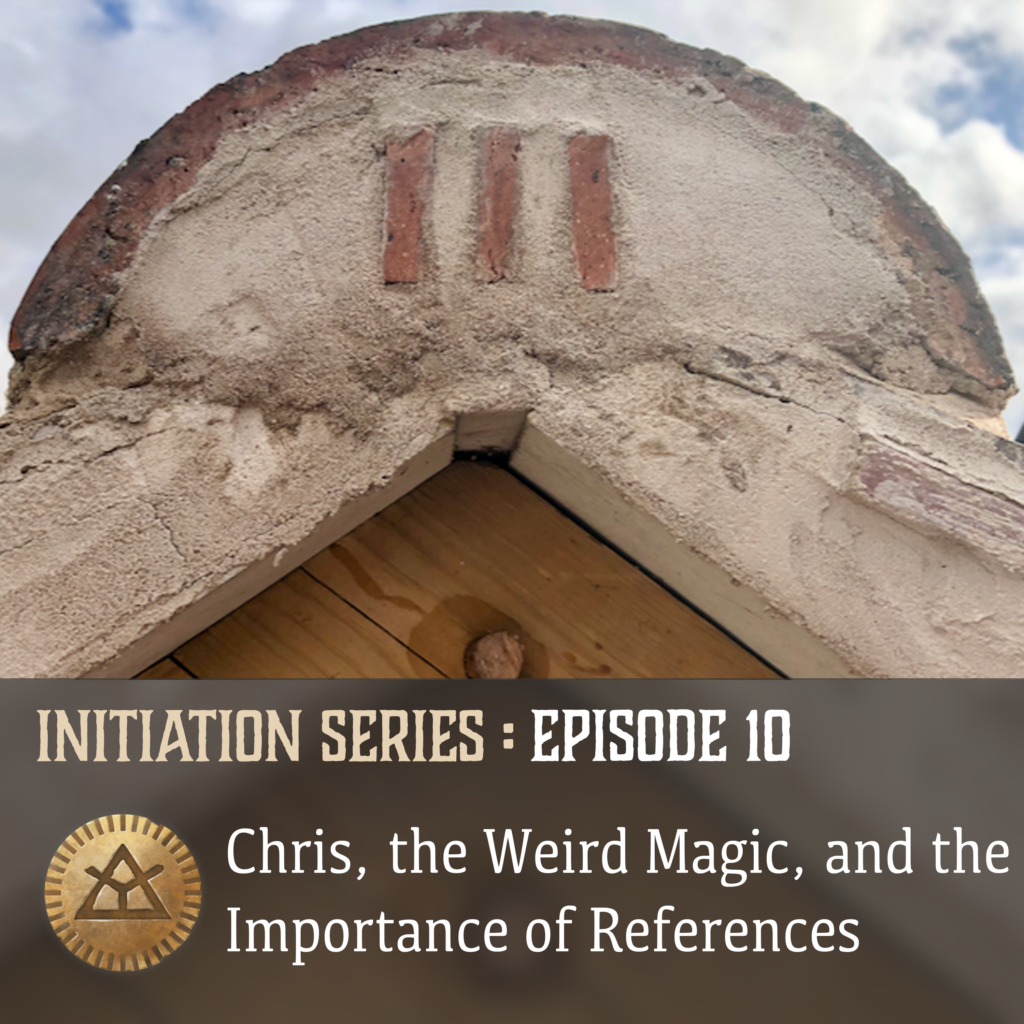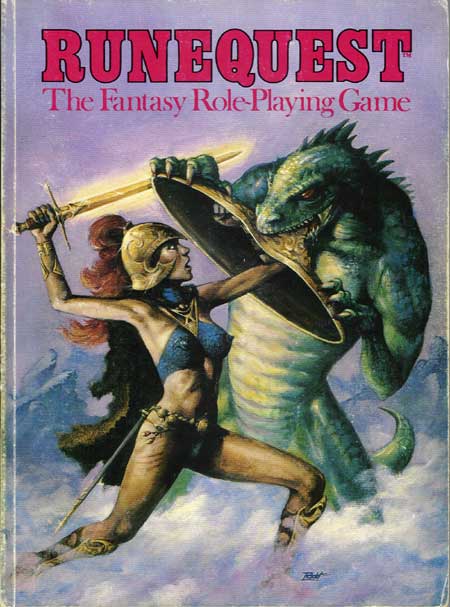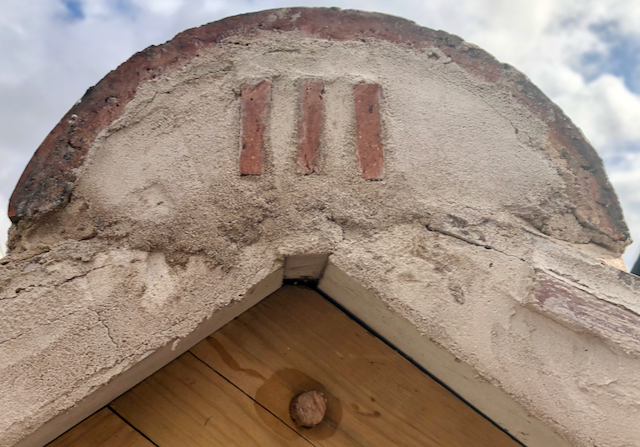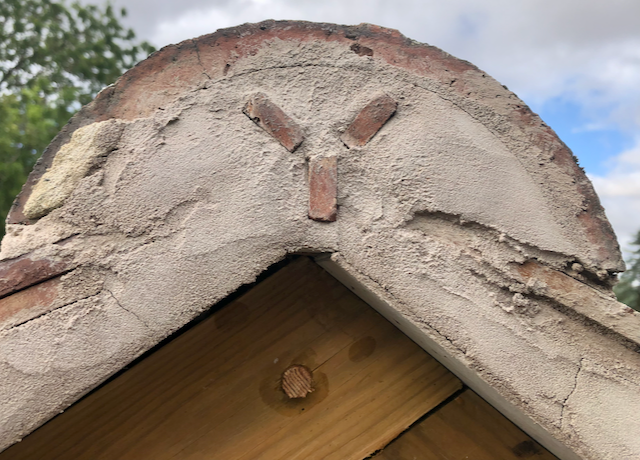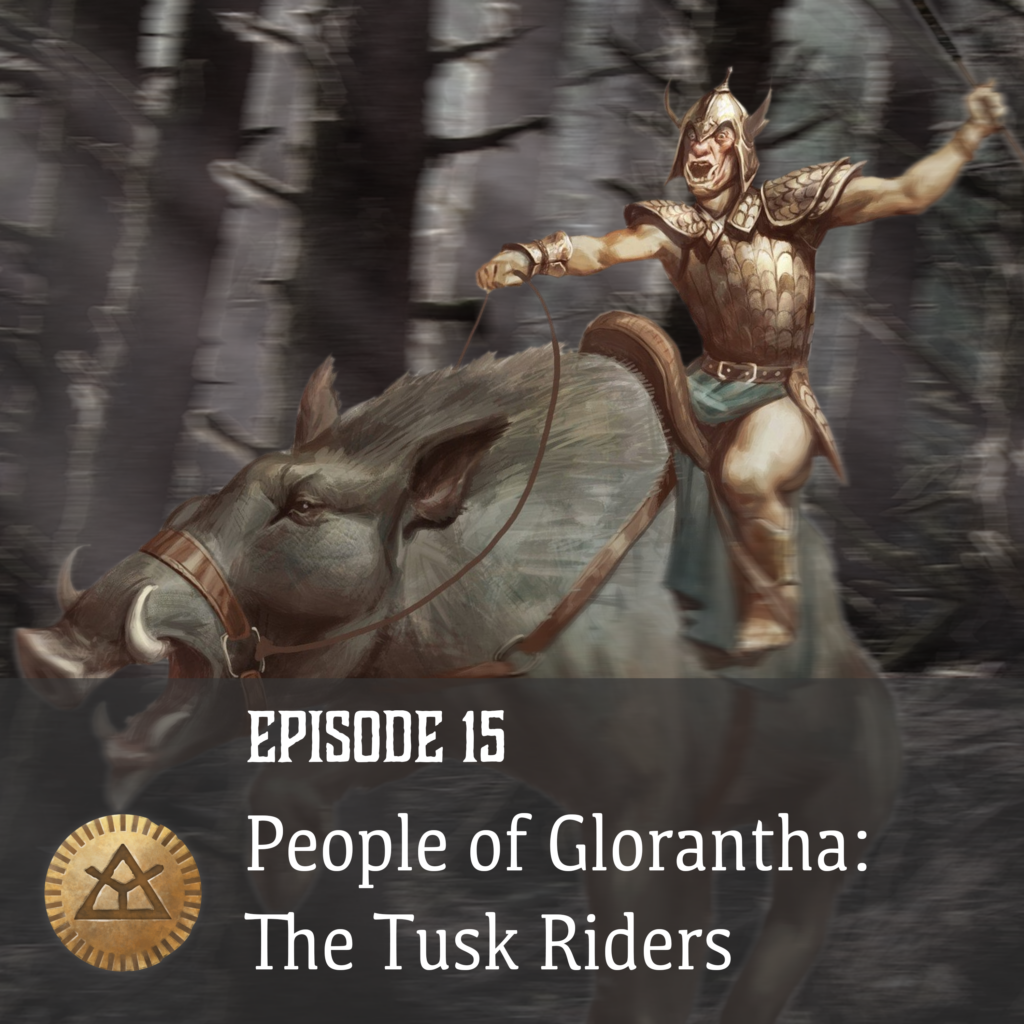
Our guest for this episode is Dom Twist of the Beer With Teeth writers’ (and gamers’) collective, known for his contributions both in a couple of Chaosium publications (Pegasus Plateau‘s Crimson Petals, and Weapon and Equipment Guide) and for various Jonstown Compendium publications by Beer With Teeth (including Dregs of Clearwine, Cups of Clearwine, Stone and Bone, and Rocks Fall).
Dom is another returnee to the podcast, debuting in episode 4: Writing Adventures in Glorantha.
This episode was recorded in early August 2022.
News
More up to date updates are available from Ludo’s weekly Journal of Runic Studies newsletter.
The Weapons & Equipment Guide made its debut in hardcover at GenCon after a previous PDF release late in 2021. Dom points out that this is going to be the last publication with a PDF release before the printed product. Ludo refers to a statement of Rick Meins reported (and commented) in issue 59 of the Journal of Runic Studies.
Ludo reports on the dates for the next Chaosium Con, which will happen April 13 to 16, again in Ann Arbor, Michigan.
Dom talks about his plans to go to Continuum 2023 (first time it changed to annual turnover) and Dragoncon.
Children of Hykim by Brian Duguid is out on Jonstown Compendium.
We discuss the rune point cost of turning into a totemic beast.
Dom is enthusiastic about the quantity and quality of the Jonstown Compendium and the RuneQuest: Roleplaying in Glorantha releases.
The first volume of Duckpac was out at the time of recording, but by now there are already three of the announced four volumes available.
Chaosium interview with Jeff Richard on game balance.
Main Topic (“It is boaring”)
Ludo presents Dom as the person referred to us as an expert on these guys.
We assume that listeners have at least the RuneQuest rulebook and Bestiary, but Ludo does a 20 seconds presentation of the Tusk Riders
Public Knowledge
What would the average Gloranthan know about the Tusk Riders?
Jörg points out the chance of the adventurers parents having participated in the Boar Hunt of 1606, and Ludo mentions the one of 1622 that adventurers could have participated in themselves.
Dom states that in the eyes of the average Gloranthan of the region, the Tusk Riders are evil: they raid, not just for food and loot, they also want to capture and torture people for their magic.
Dom explains that each Tusk Rider is paired with one of these giant Tusker boars, pretty clever beasts totally dedicated to their riders.
Dom compares them to Sir Ethilrist’s Black Horse cavalry.
The Tusk Riders are heavy cavalry who move unimpeded through forests
We talk about gaining the alliance of a large number of Tusk Riders by sacrificing an entire unit of militia as sacrifices to the Bloody Tusk.
Jörg points out that they breed like pigs, too, replenishing their numbers within very few years.
Ludo talks about what happens to their captives, whose spirits remain enslaved after being tortured to death. We speculate how much of the details of this are known to their foes, and how much of the in-world lore about the Tusk Riders is factual and how much is hear-say or superstition.
We agree that the Tusk Riders are bad to the bone, and thus an excellent foe or boogeyman to throw at adventurers, whether in person or whether just as rumours.
Publication History
Ludo brings up their exonym “Orcs on Porks”, at least among roleplayers.
Dom reminisces about orcs in RuneQuest and other systems.
Jörg boars with the publication history, beginning with RuneQuest 1st edition which already had stats for most of the creatures mentioned in White Bear and Red Moon/Dragon Pass and Nomad Gods.
In White Bear & Red Moon (WBRM) they already had that alliance requirement of sacrificing a unit of soldiers, and a couple of other traits later realized in their expanded descriptions.
Ludo points out that there were Tusk Riders that could be hired as mercenaries or used as adversaries in Snake Pipe Hollow, one of the early scenarios for RuneQuest.
Dom mentions the Judges Guild RuneQuest scenario Broken Tree Inn, located near Snake Pipe Hollow and thus near the Stinking Forest, which features them too.
The Tusk Riders get a fuller description in 1981’s Borderlands campaign, with a full page on their culture and history, and as antagonists in one of the seven scenarios.
Dom relates his recent experiences encountering Tusk Riders as opponents for a player character of his, in the Borderlands campaign, pointing out the enmity between his Daka Fal shaman and all the Tusk Riders stand for.
Jörg points out that the text passages in the earlier publications often were re-used verbatim in later publications (WBRM; Wyrm’s Footnotes 3 in the Guide to Glorantha, the NPCs of Borderlands in HeroQuest’s Pavis: Gateway to Adventure, RQ3 Elder Secrets in the RQG Bestiary), which on one hand is nice that the newer material contains most of the information the older publications had, but limits the actual amount of text written on the Tusk Riders.
Ludo speculates about why the Ivory Plinth poem gets recycled again and again (Wyrm’s Footnotes #3, Wyrm’s Footprints (the “Best of Wyrm’s Footnotes” by Reaching Moon Megacorp, under an Issaries license, mostly with material that went into the Sourcebook), the Guide to rGlorantha, and the RuneQuest: Roleplaying in Glorantha Bestiary). Jörg muses that the poem makes fleeting mention of so many places and events that were never explained that this is the only way to preserve them. Dom points out that the poem was created by Greg Stafford, and that Greg himself was not a stickler for remaining absolutely true to what he produced years ago, unlike some other contemporary brand.
Troll Pak riffs on the half-troll connection and introduces their role in the troll civil war during the Inhuman occupation.
King of Sartar expands on that conflict, and The Smoking Ruins scenario book further expands on this.
Coming into Glorantha with the current RuneQuest rules, already the first scenario in the GM Screen pack features them.
Dom points out that the presence of Tusk Riders cannot be ignored by responsible leaders or problem solvers, as they are certainly going to come and take captives and plunder, if they haven’t already done so and you need to free their victims, or at least release their spirits.
Theory Crafting and Fake History
Ludo leads into this by pointing out that we don’t know the canonical situation, and that the Tusk Riders themselves when talking about their past are known as liars making impossible boasts.
Dom mentions the human hero Aram-ya-Udram, a human hero who boumd a Darkness Spirit to him. After the Dark Night Ermaöda sent the God-Pig Gouger to exact vengeance for improper worship or even blasphemy.
Here’s a work-in-progress picture of Aram by Loic Muzy for the Cults of Glorantha book:
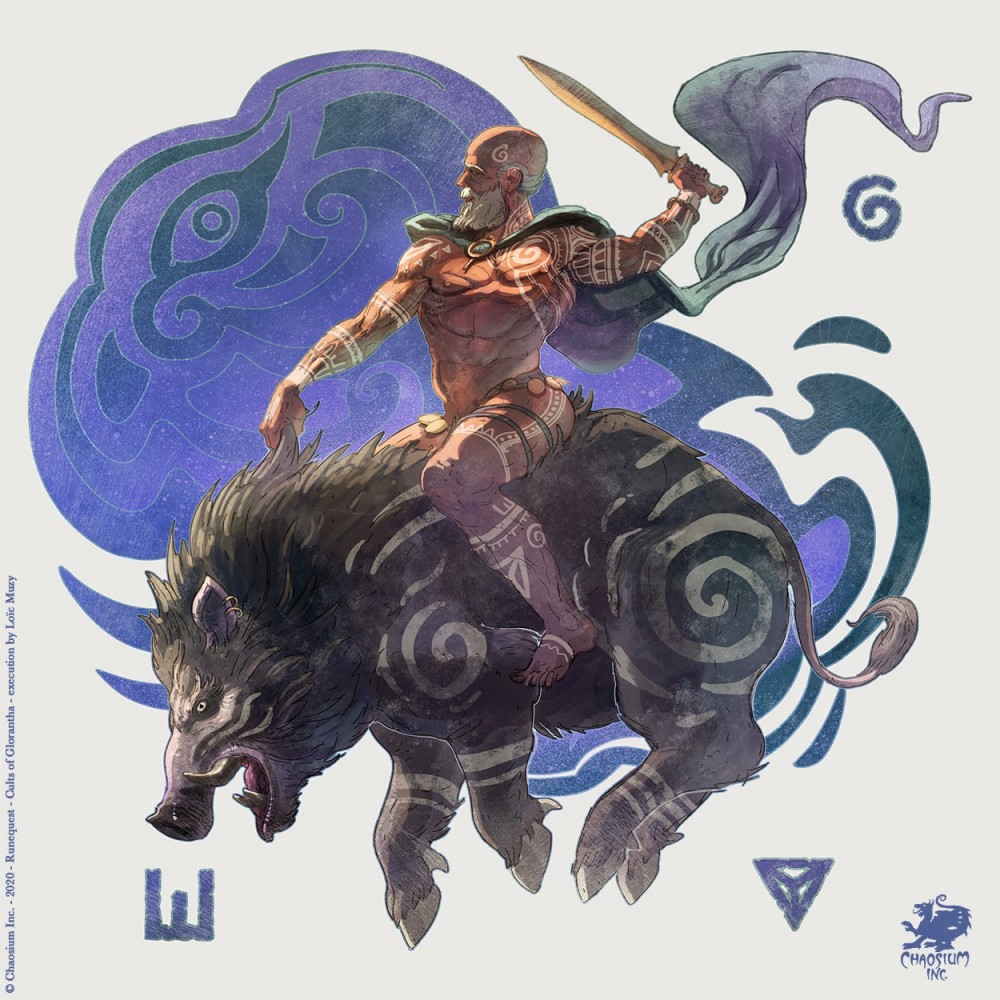
Dom speculates that already Aram heroquested to turn his people into the half-trolls and worshippers of the Darkness demon.
Dom teases a follow-up scenario for Defending Apple Lane while talking about Red-Eye, the divine /demon pig residing in or around Pig Hollow in the Colymar Wilds.
Ludo spoilers Defending Apple Lane (but you’ll have to listen to the podcast to hear this)
Jörg protests that Dom is maligning good old Aram-ya-Udram, who was after all the human representative on the World Council of Friends in the first century after the Dawn, and a civilized man.
Ludo offers a (in his words) half-assed theory about the Aramites, Tusker-riding humans living in the region of what would become the Ivory Plinth, an ancient ziggurat temple in the Stinking Forest (then still known as the Tallseed Forest).
Then some people disrespected the Earth, becoming complacent stopping proper worship of Ernalda, getting punished by sending Gouger to take revenge. Aram tricks Gouger, using his Darkness Demon, slays the God Pig and sets up his tusks at the Ivory Plinth.
Ludo theorizes that Aram’s people lost their agriculture, becoming hunter-gatherers and mercenaries riding the Tusker boars that could be tamed thanks to Aram’s feat slaying Gouger.
Later, during the EWF, the human Tusk Riders approached some Mad Scientist working in the EWF to make them more powerful
Ludo riffs on the Tusk Rider claim that once upon a time they had 12 kings each ruling their kingdom, and suggests that the experimentators had 12 experimental specimen of Aramite stock who somehow escaped the experimentators, taking bloody revenge (to loan from the Akira anime/manga) and starting the half-troll Tusk Riders we know today.
We digress shortly on the Remakers – Ludo suggests gene-splicing, Joerg advocates classical stitch-up chimeras like Frankenstein’s Monster or Doctor Moreau’s Island.
Ludo points out that according to one source, the Darkness spirt bound by Aram and used to slay Gouger disappeared into a void of Chaos, and that bringing back that spirit as their God of the Bloody Tusk may have corrupted them.
Dom thinks that that corruption has more of a Chaos feel and points out that there is a know Void of Chaos right on the edge of the Stinking Forest, below Snake Pipe Hollow. Dom points out that we know for a fact that in the EWF there were these experiments which resulted in the Beastmen, but thtat there were other ways the Beastmen came to be, and with the heroquesting going on in those times everything could be true to some extent, or made to tbe true.
Ludo wants his players to stumble on an old experimental complex of the EWF experimentators, with numbered holding cells destroyed, apparently from within, and gruesome victims of that escape fossilized in some way or written records made by the experimentators.
Jörg points out that the list of Dawn Survival Sites in the Guide (or History of the Heortling Peoples) also mentions a Tusker-riding nobility among the Harandings at Marlothenyi, in northern Esrolia.
Those Harandings feature in the original Lawstaff Quest (first presented in King of Sartar and used as a scenario in the Orlmarth campaign in HeoQuest’s Sartar: Kingdom of Heroes), where their king Harand Boardick pawns a son to his troll ally Jago Zaramzil to gain their support in his attack on Arrowtop Mountain.
They also lived right next to the Entruli of Maniria and Slontos, descendants of the Pig Mother, and possibly the people Harand’s mother came from.
Jeff put up some stuff on the Well of Daliath that indicates that Aram was helping Lalmor of the Vathmai (an Entruli clan or tribe living in or near Esrolia) bring the Lightbringer Ways to the Entruli.
The Entruli king had done some rather unspeakable things which caused his city to sink below the Mournsea, and some other cities to be destroyed. Jörg speculates that this was the transgression against Ernalda which caused Gouger to rampage against those cities, continuing to destroy human habitations as the God Pig moved east into Esrolia and beyond into Dragon Pass. Jörg speculates that Aram’s companions hunting down the God Pig might have been a warband of Haranding nobles who followed the pig all the way to the Stinking Forest, and then settling down there without any gardeners of farmers, making a living as mercenaries, hunters and gatherers.
The timetable is a bit messed up, but that isn’t that unusual in Gloranthan history.
A literal reading of the Dawn Sites documents suggests that Gougers tusks were already in place at the Dawn, which means that Aram slaying the God Pig would have happened in the Silver Age, or even earlier. But then, Ernalda went to sleep some time around the arrival of the Chaos Horde to fool Nontraya and his hordes of the Dead and didn’t really have the means to send an avenging pig or complaining of not receiving the correct worship until after the Dawn.
Jorg boaringly goes on to list the named leaders of the boar riders throughout history.
There was the leader of the center of the Orlanthi contingent at the Battle of Night And Day, Old Swine Dezar, leading 150 Tusker-riding warriors into the battle.
There was the Great Living Hero of the EWF in the Machine Wars, Varnakol the Mangler, a boar rider who had tusks and two named axes, whose enemies preferred death by his axes to being captured by him.
And finally there was Karastrand Half Troll, “leader of the boar-riding trolls of the Rockwood Mountains”, during the Troll Civil War in the Inhuman Occupation. Karastand claimed imperial human ancestry-
Jörg has the wild theory that the son given up by Harand Boardick in the Lawstaff Saga got adopted and reborn as a troll and fathered a lineage of boar-rider trolls in the Rockwood Mountains, and that that lineage and the (already EWF-modified) Aramites around the Ivory Plinth crossbred, making that half-troll ancestry true at least for this leader and his siblings, possibly as an adoption ritual similar tto that Pain Centaur spiel that Ironhoof used to adopt the Pure Horse Folk survivors of the Battle of Alavan Argay to found the Grazeland pony breeders.
Ludo wonders how this could be brought into a game (where Jörg assumed that any Sage worth their ink and/or facial hair would happily collect such information).
Making Games More Boaring
Next we start talking about using Tusk Riders in games.
Dom suggests that the Tusk Rider ritual to turn captives into one of their kind is not limited to humans but that it also works on trolls.
Jörg mentions the thread on BRP Central on Tusk Rider adoption. Dom points out the Tusk Rider adoption story-line in the xomputer/mobile game King of Dragon Pass, and using that in your own campaign.
Dom quips that they are sort of the Hells Angels of Gloranha, coming to beat people up, take their stuff, riding hogs.
The BRP Central thread had a suggestion that someone might quest to return the Tusk Riders to their less unpleasant human form, although we wonder who would go for that trouble.
Dom poins out the Sons of Anarchy TV show which is about a criminal biker gang, and how that could be used for some Tusk Rider plots, and that the Tusk Riders should be intelligent and clever opponents.
As they have low charisma, the leaders of a warband will lead by intimidating their followers, and by providing results.
Ludo points out how the Tusk Rider antagonists get decent tactics, acting intelligently. Dom suggests that they wish to harvest the most magical of their opponents, and that they lure them into their kind of territory by abducting dependents.
Dom points out how binding enemies’ spirits creates a magic economy for the Tusk Riders that forees them to capture other people to become powerful, which they need to survive in Tusk Rider gangs, especially as leaders. All that stolen magic makes them strong and unpredictable magical foes.
Dom describes how hit and run tactics may be used to make their opponents cast expensive spells, only to sit those out until they expire, and then hit again. They have the magic of their bound spirits in severed hands or tails to power their spells, and may use their Tusker as an allied spirit, too.
For capturing foes, they may use lassos or similar, then dragging their victims through the forests which cannot be healthy.
Ludo asks about how to stage the hit-and-run using RQG rules (like e.g. the chase rules), or whether to handwave (which is how Dom prefers to run such things, more narratively). Dom points out how the Tusk Riders are vulnerable to missile fire when doing that, as their major tactical flaw.
Ludo describes how he had the characters of his “we all play children” campaign happen on the site of a Tusk Rider massacre, and then catch up with exhausted Tusk Rider survivors of that combat, playing them dumb to match the abilities of the underage characters.
Dom describes how he ran a sequel to Defending Apple Lane where the sister of the leader of the first attack (who lost quite a few minions, and leadership) comes not so much to take vengeance but to harvest those interesting magics of the player heroes, preparing ambushes and traps for luring them into pursuit after capturing some dependents in the hamlet.
Ludo explores where Tusk Riders typically set up their bases.
Dom suggests that a Thane of Apple Lane who successfully dealt with Tusk Riders and possibly Red-eye multiple times may become a status target for ambitious Tusk Rider leaders or wannabes.
Speaking of typical boons earned by player characters Im the official adventures, Jörg asks how Dom would handle a conflict between hippogriff-riding heroes and Tusk Riders. “Into the woods” would be the Tusk Rider reaction to such opponents.
Dom goes on to describe the Stinking Forest as a war zone where Tusk Riders, trolls, elves, dwarfs and giant spiders may slug it out, allowing any playee heroes to experience crossfire situations.
Ludo talks about how there might be secret shrines to the Cult of the Bloody Tusk very close to area deemed safe by the player heroes, with pilgrimages bringing victims there. Jörg suggests to use the Broken Tower as a possible holy site for Tusk Riders, sparing the GM a lot of prep time.
Ludo talks about somewhat “friendlier” Tusk Rider neighbors that will take ransom payments, or engage in clandestine trading, which Dom brings back to the plot hooks that can be lifted from Sons of Anarchy.
Dom mentions the problems that might arise when a party healer (possibly the NPC follower) gets taken by Tusk Riders. Do you want to face Tusk Riders with powerful healing magic, or the Sleep spell? Tusk Riders are one of the few non-chaotic Gloranthan foes who would have no qualms killing Chalana Arroy healers.
Jörg brings up the possibility of using the Tusk Riders as a playable race. We talk about how to play characters who are bound to torture people to keep up magically, and how this needs buy-in by the players, and careful off-screen handling of the unpleasantness.
Dom mentions the scenario that a gang of Tusk Riders who may have plagued you the past few seasons offering their services as mercenaries
Dom spiced up his Tusk Rider threat by having them carry newly minted Lunar Tarshite coins, to trigger player character paranoia. Dom expands how an able Lunar commander might send out a special operations team (effectively a player character party managed by the GM) to stir up feuds and banditry in the rebelling province of Sartar, with Tusk Riders a good choice to spread terror and distraction.
As time runs out, Jörg thinks that we have boared people enough, and Ludo hopes we made people loathe / love them as much as we do.
Credits
Cover image by Cory Trego-Erdner.
The intro music is “The Warbird” by Try-Tachion. Other music includes “Cinder and Smoke“, “Skyspeak“, “Stomp“, and “Sjaman’s Dream: Fire“, along with audio from the FreeSound library.
Podcast: Play in new window | Download (42.9MB)
Subscribe: Apple Podcasts | Spotify | RSS | More


